Preparing grapes for winter: the secrets of processing in the fall before shelter
Vineyard preparation to cold weather - an obligatory stage of agricultural cultivation. A certain set of measures will strengthen the plant's immunity and provide forces for laying the next year's harvest.
The article will tell you how to properly prepare the vineyard for winter and what procedures are especially important for the plant.
The content of the article
Rules for preparing a vineyard for winter
The processing of grape bushes to shelter consists of several stages. The main actions include sanitary and preventive work and feeding.
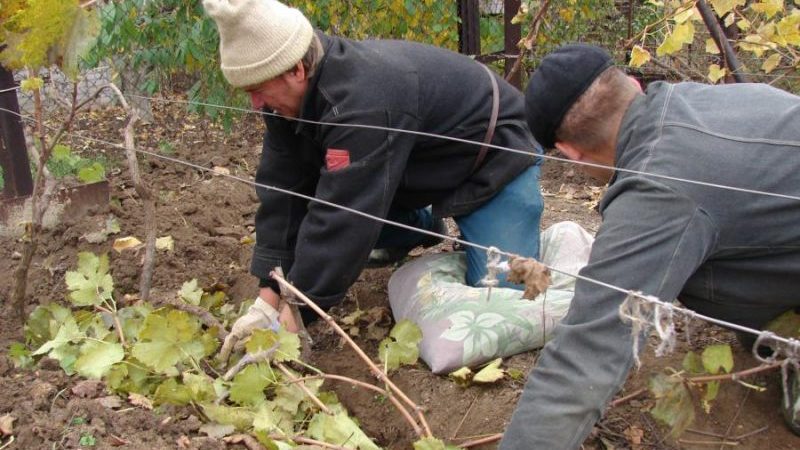
Pruning
Autumn pruning of grapes is needed for the formation of a bush, the correct ratio of the ground and underground parts, and the removal of diseased shoots.
Pros of pruning in the fall:
- reduction of the crown for the convenience of shelter;
- stimulation of early bud opening;
- fast healing of wounds.
The main disadvantage of pruning is the high probability of freezing and brittleness of the top of the shortened shoot, but only if the procedure was carried out in late autumn on the eve of frost.
The best time to remove excess shoots on grapes is after the first frost, when the vine matures and the sap flow slows down. Active yellowing and falling foliage indicate the preparation of the plant for the rest period.
Important! Pruning too early will prevent young shoots from ripening, they will dry out, or their buds will form late and give a meager harvest. They are also more prone to infections.
Planted this year, the bushes are not cut off, but only the leaves that have not fallen are removed.
Watering
If in the autumn after harvesting there is no rain or they are insignificant, then water-charging irrigation is carried out. He will provide the vines with water until the next summer and during times of drought. The soil saturated with water does not crack from frost, protects the roots from damage.
The irrigation period for mid-season varieties is mid-October-early November. Late varieties stop watering 30 days before harvest.
Sandy soils require less water but dry out faster. Clayey ones are irrigated less frequently, but more abundantly, taking into account the depth of groundwater.
Water the plants in the evening, in the pre-prepared basal holes, if there are no irrigation pipes. The water should flow out slowly, without getting on the foliage and stems. The depth of soaking is within 1-1.5 m. In the morning, the dry crust on the ground is loosened, the recesses are sprinkled with earth.
If it is not planned to shelter the bushes for the winter, irrigation is carried out after the foliage has fallen. In the opposite situation, already warmed plants are watered.
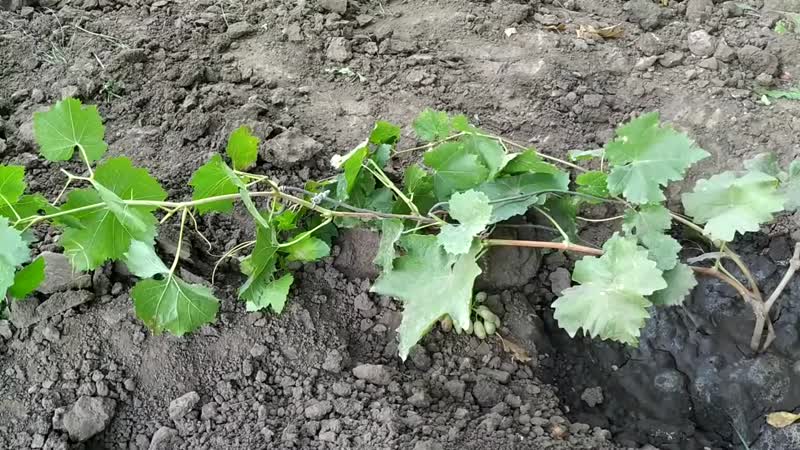
Top dressing
By the time the harvest ripens, grapes deplete their reserves of nutrients. Autumn feeding fertilizers based on potassium, phosphorus and trace elements will provide preparation for wintering. Adequate nutrient levels will restore strength for the next growing season and strengthen flower buds.
Treatment against diseases and pests
Autumn destruction of wintering pests and pathogens will preserve the health of the bush until spring and during the growing season. Treatment and preventive treatment is carried out before the shelter for the winter. Reducing the number of parasites and pathogens by digging the land around the vine bushes.
It is interesting:
Shelter
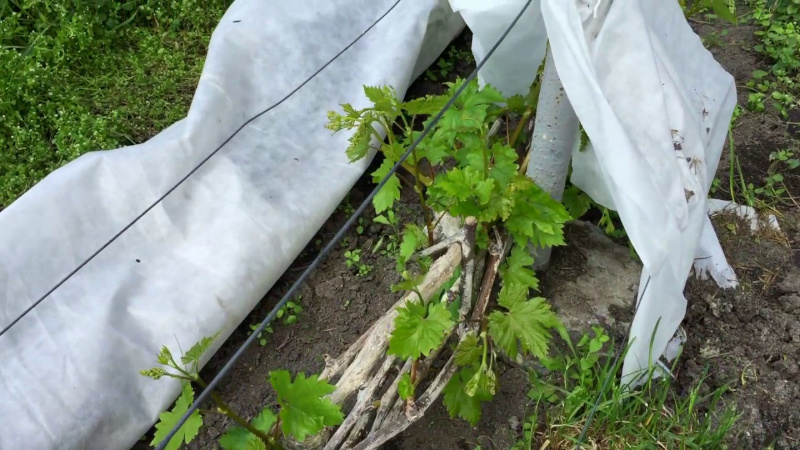
Protecting the grapes from frost is a must. The most vulnerable is the root system, it is insulated especially carefully. If the soil under an unprotected bush freezes to -5 ° C, the risk of plant death will increase significantly. Frostbite on the ground parts of the bush will reduce the quality and quantity of future grapes.
However, the first autumn frosts must be transferred to the grapes uncovered - this will positively affect the frost resistance of the plant. Insulation is carried out at stable negative temperatures: 1-5 ° C frost in the daytime, up to 7 ° C at night.
The most popular grape shelters are:
- pine or spruce spruce branches;
- straw;
- Earth;
- roofing material, film, non-woven material.
When to process grapes in autumn
The processing of grapes is carried out after the complete collection of berries, foliage falling and closing of the buds. During this period, the maximum infectious background is observed. First, they carry out a sanitary pruning shoots, then the bush is sprayed with various solutions. Early cultivars are cultivated primarily to prevent the spread of pathogens to nearby bushes.
How to feed the vine
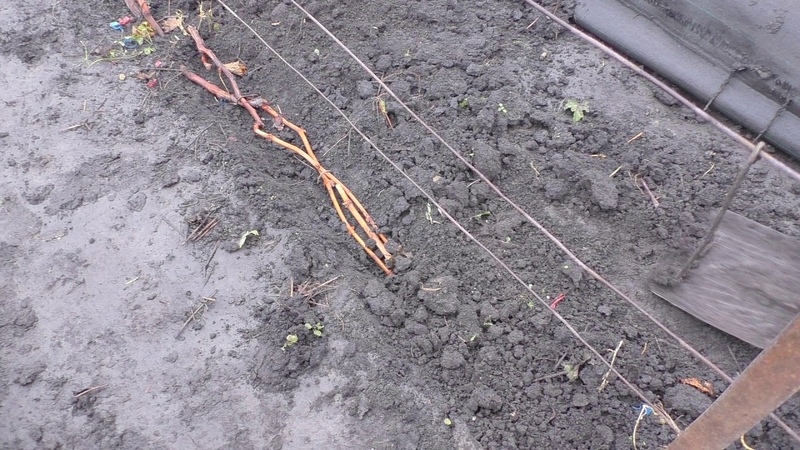
Autumn feeding begins from the third year of the life of the vines. The main macronutrients are phosphorus and potassium. For immunity, trace elements zinc, copper, magnesium must be included in the fertilizer.
An example of a complex mineral mixture for 10 liters of water:
- 20-25 g superphosphate;
- 25 g of potassium sulfate or 10 g of potassium salt;
- 1 g of boric acid, 1-2 g of zinc sulfate.
Dissolve the granules thoroughly in 1 liter of warm water, then pour the mother liquor into the rest of the water. The resulting solution is poured over 1 sq. m vineyard.
Dry application of mineral fertilizers is possible. The mixture is scattered on the near-trunk area and watering or deep digging is carried out.
Reference. Not the most depleted soil can be fed with wood ash at the rate of 300 g for each bush. It contains a lot of potassium, trace elements, neutralizes the acidity of the soil and repels harmful insects. Ash is brought in dry during autumn digging or a weekly infusion is made in 10 liters of water.
It is allowed to introduce organic materials that improve air permeability, microbiological composition of the soil, make its structure looser. Suitable in this capacity:
- Rotted manure diluted in water in a ratio of 1: 4. For 1 sq. m of land, 8-10 liters of such a solution is enough.
- Bird droppings. For 10 days, it is soaked in water, in a ratio of 1: 4 and placed in a warm place. Before applying to the ground, it is additionally diluted with water to a ratio of 1:10.
- Well rotted compost. It is poured in a layer of 5 cm under the grape bush and sprinkled with soil.
How to spray grapes in front of shelter for the winter
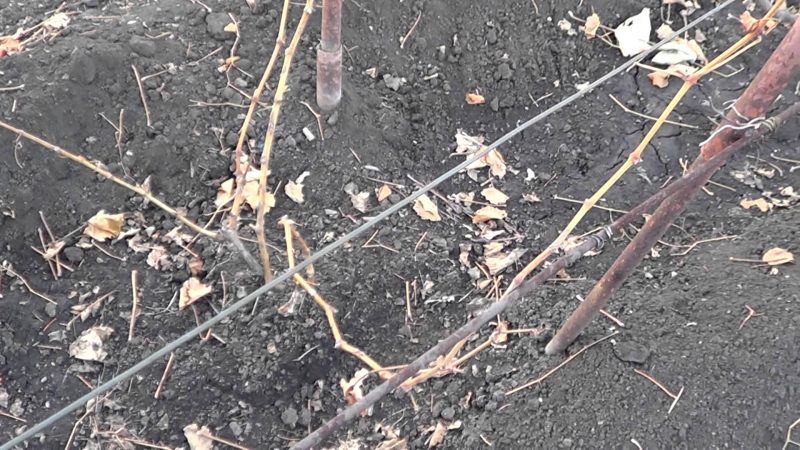
Autumn spraying is a mandatory measure to protect the crop and stimulate its fruiting in the next season. At this time, the use of aggressive agents is allowed, which are aimed specifically at destroying diseases and pests, and not at curbing their development.
The use of chemical compositions
Most modern insecticides that successfully perform their pest control functions are used in the spring and fall. They are subdivided into contact and systemic drugs. The chemical action of the former is based on the direct destruction of insects and their offspring.
Examples of popular drugs:
- Akari;
- "Avant";
- "Confix";
- "Travertine".
The problem is that often, after using them, pests develop resistance to the chemical. In this case, systemic insecticides help, as they penetrate deep plant tissues and prevent insects from waking up in spring from feeding.
Well proven:
- "Aktara";
- "Commander";
- "Calypso";
- Biotlit.
Acaricides are used to combat all types of ticks.
Examples:
- Antelik;
- "Neuron";
- "Freemason";
- "Steam".
Pests often hide in the soil, in cracks in the bark of the vine, in the root soil.
Fungicides are used to combat fungal and viral diseases. For autumn spraying, contact-protective preparations are suitable:
- Fundazol;
- "Euparen";
- "Dnok";
- "Cupritox";
- "Strobe";
- Bayleton;
- "Nitrafen".
Ridomil Gold and Topaz are formulations with a powerful therapeutic and prophylactic mechanism. They are mainly used for autumn processing, as they can accumulate in berries.
The use of folk remedies
Many popular methods of protection are not inferior to industrial drugs - the effect of such remedies has been tested and confirmed by years of practice.
Copper sulfate
Copper sulfate is one of the least toxic drugs. Destroys disease-causing strains, disinfects the plant for a long time. The solution is made in warm water, in a ratio of 1:50. The composition is good for 5 hours, then it loses its beneficial properties and changes its structure.
Processing is carried out after leaf fall, in two stages with an interval of three weeks, before the onset of frost. All bushes and soil around are sprayed. Copper sulfate forms a breathable film on the shoots, which additionally helps to keep warm.
Bordeaux liquid
Bordeaux liquid is especially effective against black rot, anthracnose and a number of other fungi. The finished composition is sold in garden stores, but you can prepare it yourself. The maximum safe concentration for grapes is 3%.
For the solution you will need:
- 10 liters of water;
- 450 g of quicklime;
- 300 g of copper sulfate.
In a non-metallic container, vitriol and lime are diluted separately in 1 liter of boiling water. Both liquids are filtered and poured into a common container, stirring constantly until smooth. The concentrated solution is added to the rest of the water.
One bush takes about 1 liter of the finished liquid.
Urea
A universal agent for feeding and protecting - urea. It prevents the spread of scab, aphids, copperhead, weevils.
Take 500-700 g of urea on a bucket of water and dissolve thoroughly without sediment. The bushes are sprayed 1-1.5 months before the first frost.
Soda with potassium permanganate
Solutions of soda and potassium permanganate fight powdery mildew, gray mold, oidium, eliminates caterpillars. Additionally, they act as growth stimulants, rejuvenate the grape bush, and improve the taste of berries.
For a solution of potassium permanganate, take 1 g of potassium permanganate per 200 ml of water. If you add boric acid, you get an excellent root feeding with microelements.
Soda antifungal solution is prepared from:
- 1 tbsp. l. baking soda;
- 1 tbsp. l. any vegetable oil;
- 100-200 ml of liquid detergent.
All components are mixed in 10 liters of water. The composition is harmless and applicable at any time of the year.
Barrel processing
To prevent fungal infections and mold from spreading to the shoots, it is recommended to process the trunks with slaked lime.
For 5 liters of working fluid, take 500 g of quicklime and pour it with 1 liter of water. The thoroughly mixed product is applied with a brush to the lower parts of the thick stems of grapes, paying particular attention to the cracks in the bark.
Spraying rules
- Any spraying is carried out in dry, calm weather, in the evening.
- The bushes should not have any usable bunches.
- The solution should cover the plant with a thin layer on all sides.
- Chemicals are diluted in the dosage indicated by the instructions.
- It is advisable to fix the result with a repeated procedure in a week.
When working with chemicals, a prerequisite is the use of rubber gloves, a mask or respirator. This will protect the skin and respiratory system from burns and intoxication.
When to cover after spraying
Cover the vines for the winter after the last planned treatment. Insulation material helps to maintain the integrity of the applied layer of the substance.
Conclusion
Autumn processing of grapes directly affects the laying of the next year's harvest, significantly increases the frost resistance of plants. Preventive measures to combat pathogens and pests will prevent their possible development, reduce work in the spring.